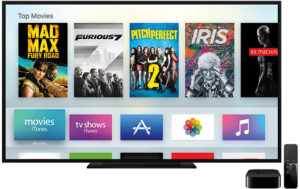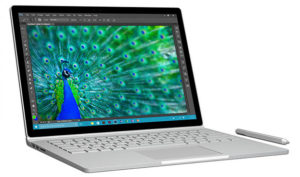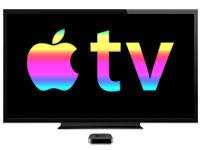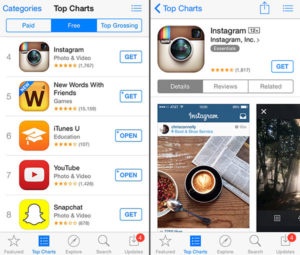
Microsoft is positioning its new Surface Pro 3 tablet as alaptop replacement device — instead of competing head-to-headwith the Apple iPad. However, the Surface Pro 3 naturally invitescomparisons to both the MacBook Air and the iPad Air. Plus,Microsoft has had plenty of time to smooth the rough edges fromWindows 8 and build a more competitive mobile device… . So what’sgreat — or overblown — about the Surface Pro 3? And can it really bea laptop replacement?
As an Apple-oriented tech user, I must admit I like the Windows 8tiled, touch and swipe Start screen interface. It’s innovative, and it isa much better app launching system than Apple’s Mac OS X Launchpad,which has limited functionality and makes a guy like me feel like I’mstuck in a jaunty cartoon. Still, once you get beyond the Windows 8Start screen, you’re still using a PC with PC apps in a Windows world.No getting around that. Can innovative hardware make thedifference?

As I started delving into Microsoft’s Surface Pro 3 announcement and checking outthe new hardware specs, my initial thought was that Microsoft hascreated a lighter device that boasts a bigger screen, better batterylife, a better trackpad on the keyboard cover, an improved kickstand,and a cool Surface Pen (previously known as a dorky stylus).The processor specs are solid enough to bridge the gap betweenpowerful tablet and working PC. And — there’s more — the SurfaceDocking Station accessory is capable of supporting a huge 4K externaldisplay.
Technically, it all seems interesting and useful. Yet somethingis still wrong. Very wrong. Let’s tease it out.
Tablet as True Laptop Replacement?
Microsoft seems to understand that it is in no position to offer adiscrete tablet that can compete with the popularity of the svelteiPad Air, Apple ecosystem — or even the Android tablets availablenow. But can it play in the workhorse business world of the laptop in a post-PC era?You bet. That, at least, seems like a possible way to win.
Most every working professional I know has a love-hate relationshipwith their iPad. They often want the multitasking and work power ofa MacBook/PC, but they like the touch interface of the iPad. Theonly answer in Appleland is to buy both a MacBook (or PC) and an iPad. There is no middle ground. There is no nuance.
This ismoderately annoying for Apple users but not enough to get in the wayof loyalty, because Apple is super clear. If you want a laptop, buy aMacBook. If you want a tablet, buy an iPad. Clarity. If you want both,then buy both. And that, apparently, is what that 96 percent of iPadowners do — they have both a Mac/PC and an iPad.
It’s what I do. Right now, there is no way that I could get througheven 50 percent of my workday with just an iPad — but is there trulya best of both worlds? Microsoft says there is. Microsoft says I coulduse a Surface Pro 3 and get everything I need in one unit. This isan awesome, tantalizing promise.
And then Microsoft shoots itself in the foot.
To be flexible and manage costs, the keyboard cover is a separateUS$130 accessory. Microsoft doesn’t understand consumers. Marketing the Surface Pro 3 as a laptop replacement but selling the keyboard cover separately pokes a hole inits ability to actually make sales, never mind create a profitable Surface division.
A laptop replacement mustinclude a real keyboard. The thought process of understandingthe add-on, compared to the message of the Surface Pro 3 — buy theSurface Pro 3 for professional work — leads to too much thinkingaround the product, which will guarantee a lackluster rate ofadoption.
With the Surface Pro 3 and its Surface Pro Type Cover accessory,Microsoft is pulling the technology equivalent of selling a blanket asa replacement for a sleeping bag but then offering zippers as anadd-on accessory.
Seriously, I cannot believe that highly paid adults in the tech worldare this stupid.Do they not see how the simplicity of the iPad product line led tomassive consumer adoption, which also led to massive business useadoption?
Instead, Microsoft’s core message is reduced to everything.This is no kind of core message. The core message it tried to convey– the Surface Pro 3 is finally the one device you can use to ruleyour world, to Get It Done — should have been supported by apackage that includes the keyboard cover. Anyone who wants a single device that canreplace their laptop sure as heck wants a keyboard as part ofthe whole tidy package.
Making it separate invites doubt. Instead of justifying the actualpurchase price of the package in their minds, buyers are caught up in a gameof math, which also invites a game of comparison. Meaning suddenly thethought process shifts to wondering if there is a better device outthere — a better way. Why not buy the Lenovo Yoga 2 13-incherlaptop/tablet hybrid instead? That’s really all-in-one. Maybe I don’tneed to replace the laptop at all… .
Mental Gymnastics
The rule is, don’t make your customers think too hard about thelogistics of how a device fits their world. Show them how. Simply.Easily. It is what it is. And then they buy.
The vast majority of the tech buying public — and businesses — havemoved into much simpler buying decisions.
How Microsoft Should Have Done It
There would be three options at most, leading with the “laptopreplacement” model that makes the most sense:
- Surface Pro 30 — Intel i5 with 8 GB RAM and 128 GB storage — and akeyboard cover!
- Surface Pro 3000 — Intel i7 with 8 GB RAM, 256 GB of storage, with akeyboard cover AND the docking station
- Surface Pro 3 — Intel i3 with 4 GB RAM and 64 GB of storage
See how simple this is? Microsoft can still offer nuances by lettingcustomers upgrade components in each of these options during thebuying process (which is what Apple does, by the way, which letsdiscerning power users still get things like extra RAM or a fasterprocessor). Or they could even remove the cover or the docking station,which flips the whole buying process into a positive spin — getting abetter deal by opting out of a component.
Suddenlythe customer feels good about not getting an accessory rather thanbeing pissed off because it’s a tacked-on extra of as-yet-unprovenvalue.
More to the point, simply by having two hard-core professional gradeinclusive options, suddenly the low-end tablet-only Surface Pro 3would seem like a steal of a deal — a way to get all the goodness ofthe Surface Pro 30, 300, or jaw-dropping “3000” powerhouse without allthe extra things a tablet-focused person might really want. Buyers could still add the Surface Pro Type Cover later if they wanted to. Or the docking station, if they fell in love with a hugemonitor.
Suddenly, the buying process is exciting. Understandable. Fun again.All it takes are some incredibly simple packaging tactics –basic, tidy tactics like the ones Apple has been using for years on its ride to globaldomination.
Instead of plopping a MacBook Air on a measuring scale at the launchevent, Microsoft would have been better served by understandingcustomer psychology and buying behavior — and then having thecorporate will to package and sell it right. The thing is, evenfrom the perspective of an Apple fan, the device itself really isn’t bad.





















































